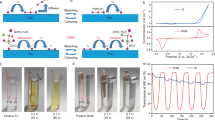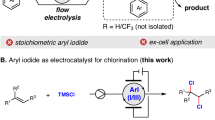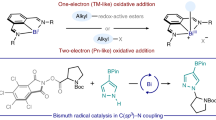Abstract
THE reaction of bismuth salts with certain organic thio-compounds, for example, thiourea and dimercaptothiodiazole, to form coloured complexes of the metal is a well-known analytical procedure. Other workers (cf. Naiman1) have reported on the detection of bismuth with a mixture of 2-methyl-benzothiazole and potassium iodide, which results in the formation of a coloured complex iodide. However, the use of such a reaction for the detection of iodides does not appear to have been reported, probably on the basis of specificity. In certain work on the colorimetric detection of mercaptoimidazoles, I found2 that the yellow metallic complex, formed by the interaction of bismuth sulphate (acid) and l-methyl-2-mercaptoimidazole, reacted with iodide ions to form an intensely coloured complex iodide. Since the reaction has been found to be specific for iodides, the use of such a reagent for their detection is suggested.
This is a preview of subscription content, access via your institution
Access options
Subscribe to this journal
Receive 51 print issues and online access
$199.00 per year
only $3.90 per issue
Buy this article
- Purchase on SpringerLink
- Instant access to full article PDF
Prices may be subject to local taxes which are calculated during checkout
Similar content being viewed by others
References
Naiman, B., J. Chem. Educ., 14, 484 (1937).
McAllister, R. A., J. Pharm. and Pharmacol. (in the press).
Author information
Authors and Affiliations
Rights and permissions
About this article
Cite this article
McALLISTER, R. Suggested Use of a Bismuth Mercaptoimidazole Compound as a Specific Colour Reagent for Iodides. Nature 169, 708 (1952). https://doi.org/10.1038/169708a0
Issue date:
DOI: https://doi.org/10.1038/169708a0



